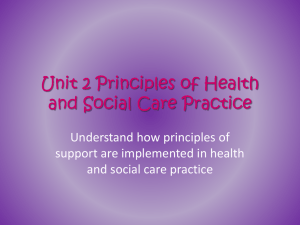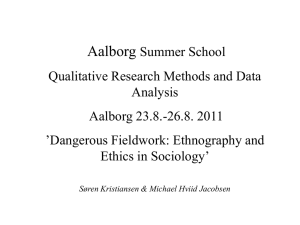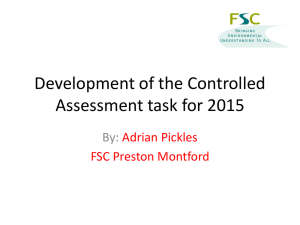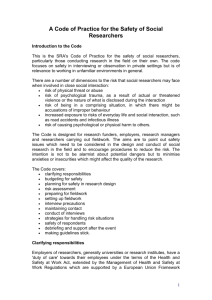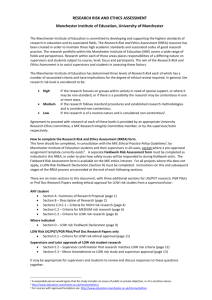Dangerous Fieldwork - Institut for Sociologi og Socialt Arbejde
advertisement
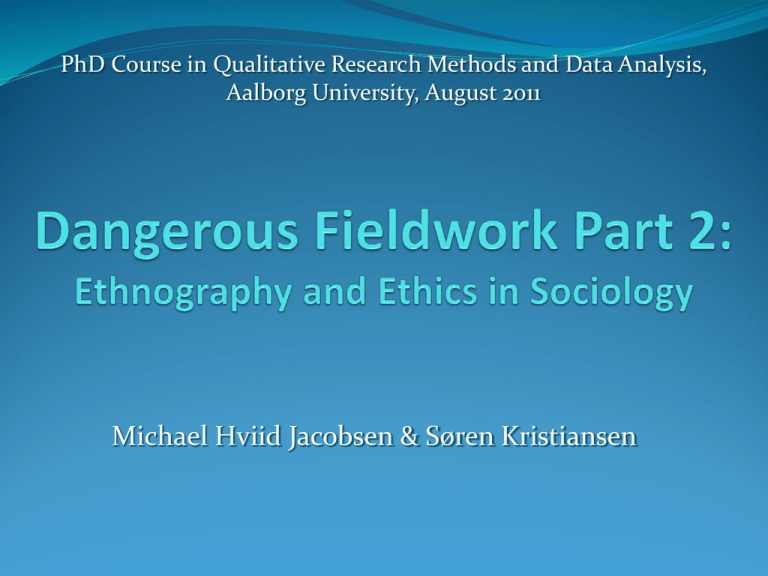
PhD Course in Qualitative Research Methods and Data Analysis, Aalborg University, August 2011 Michael Hviid Jacobsen & Søren Kristiansen Part 1 1. 2. 3. 4. 5. 6. 7. Ethnography and Sociology Fieldwork: The Relation between Researcher and Research Subjects Field Roles and Role Conflicts Ethical Complications in Fieldwork Positions in the Debate on the Ethics of Fieldwork The Codes of Ethics Closing Up: Some General Advice Part 2 1. 2. 3. 4. 5. 6. Sources of Bias in Qualitative Sociology Sensitive Sociology Emotions in Fieldwork Dimensions of Dangerous Fieldwork Situational Etiquette Instead of Iron-Clad Codes of Ethics Concluding Remarks 1. Prior knowledge (too much, too little – insider, outsider) 2. Design faults and methodological mistakes 3. Dysfunctional technical equipment (measurement problems) 4. Informant bias (wrong informants, sampling problems, etc.) 5. Researcher bias (analytical and interpretative mishaps, emotions, values, personal priorities and preferences, etc.) • An integral aspect of all social research but particularly important when researching marginalized, weak or vulnerable populations • Concerns the conduct/discretion/empathy of the researcher when investigating those who – for various reasons – find themselves in difficult or strenous situations • Although always part and parcel of research, it becomes particularly pertinent to be sensitive in behaviour and interpretation when confronting vulnerable people • The outcasts/downtrodden/marginalized people (de udstødte): A (often permanent) structural position – may lead to symbolic violence on behalf of the researcher: we most often study the bottom of society and only seldom its top positions • The sick/depressed/hurt people (de udsatte): A personal – chronic or momentary – situation (e.g. due to illness or psychic distress) that casts people in a position of particular emotional and psychological vulnerability – may lead to misinterpretation and lack of empathy (or the opposite, too much empathy and sympathy – the so-called danger of ‘over-identification’) 1. In relation to the overall taboo topics and themes of society and culture (changes over time and from place to place) 2. In relation to the concrete life situation of the individuals being researched (de udsatte og udstødte) 3. In relation to the specific research methods used (some methods and techniques are more sensitive and appropriate than others) 4. In relation to the concepts, interpretations and understanding one develops analytically (remember: words can hurt) – concepts need to be sensitizing as well as sensitive Investigating a public office in California dealing with family problems (e.g. the enforced removal of children), sociologist John M. Johnson listed the following five aspects of emotions in fieldwork: 1. The initial emotions of insecurity and anxiety when entering the field 2. Instinctive reactions to various experiences and situations (negative as well as positive) 3. Personal relations with people in the field 4. Personal relations with colleagues ‘back home’ 5. The instinctive/inner need/wish to understand the field that fuels research John M. Johnson, (1977): “Behind the Rational Appearances: Fusion of Thinking and Feeling in Sociological Research”, in Jack D. Douglas & John M. Johnson (red.): Existential Sociology. Cambridge: Cambridge University Press. The notion of ‘dangerous fieldwork’ covers all the physical, psychological, emotional, ethical, cultural or personal deprivations and distresses suffered by investigator(s) or participant(s) in social/field research ranging from physical pain and damage via mental and health related harm to loss of prestige and threats to identity. Dangerous fieldwork may thus involve varying degrees and forms of suffering or discomfort – as well as various accompanying ethical problems to be confronted 1. Researcher physical danger (physical harm, assault, bodily damage etc. as a consequence of conducting research) 2. Researcher psychological/emotional danger (mental distress etc. as a consequence of conducting research) 3. Subject physical danger (physical harm, assault, bodily damage etc. as a consequence of participating in research) 4. Subject psychological/emotional danger (mental distress etc. as a consequence of participating in research) 5. Subject cultural danger (threats to the culture or community of those participating in research) 6. Research cultural danger (threats to the career, reputation or prestige of those conducting research) Linda Dunn (1991): Research Alert! Qualitative Research May be Hazardous to Your Health: “Night after night, I would go to bed and fall asleep immediately, only to wake up in a few short hours and remain awake for the rest of the night. I diagnosed myself as depressed, by why? Exhausted, I made an appointment with my physician and obtained a prescription that would promote sleep. My inability to sleep diminished; however, extreme gastrointestinal upsets began, which necessitated numerous tests, diet changes and more tests. In addition, severe headaches accompanied neck and shoulder pains, which were treated by more medication and physical therapy. This treatment regimen was not only time consuming but a financial burden. I was becoming drained. Family, friends and peers commented about my tired appearance” Nancy Howell (1986): Occupational Health and Safety in Anthropology: “Late nights at anthropological gatherings … experienced anthropologists compare liver damage, broken legs, spectacular car repairs and the isolation from assistance when accidents occur. The knowledge that such accidents can prove fatal … apparently lightens up the discussion” Glennys Howarth (1993): Investigating Deathwork: “I frequently had reservations about my involvement in deathwork: the initial horror of witnessing bodywork, a tangible sense of tempting fate and a concern about the course of my relationship with the undertaker – a constant need to respond to his image of me as a ‘carefree and affable young woman’ clashed with my self-perception as a serious researcher. Recording inner feelings in the field diary played a significant role in keeping me in the field” Researcher Howarth’s studies of the funeral industry E.g. teasing, testing, guilty knowledge, dirty knowledge, suppression love, hatred, isolation Garfinkel’s breaching experiments Peritore’s studies of the Northern Irish conflict Zimbardo’s studies in an artifical prison facility Research subjects E.g. pain, harm, suicide, selfg-inflicted pain, psycho-somatic suffering, tourture, threats Physical Psychological/ emotional E.g. love, hatred,fear, self-hate, identityconflicts, distance E.g. pain, harm, suicide, self-inflicted pain, torture • Ruthlessness/cynicism (fortunately a very seldom reason) • Recklessness/bad judgment/lack of understanding • Bad planning/lack of predictability • Lack of/limited knowledge • Lack of/limited time and resources (shortcuts) • One’s own personal habitus/preferences/viewpoints as opposed to those of the investigated (gulf of incomprehension) • Demands/pressures from external partners/sponsors • Pre-existing tensions or conflicts in the field • Unanticipated consequences/unexpected events • Etc. The potential pitfalls/problems of the codes of ethics: Cannot stand alone – must always be applied to/interpreted in concrete social situations Universalize/banalize ethical considerations to easy-tounderstand bullet points Do not cater for ‘grey zones’ or informal social relations Focus on abstract/formal/procedural obligations Underestimate levels of discontent, discomfort or downright conflict between the parties involved in social research Understand relationships between parties in research primarily in negative terms (rules about what not to do) • One’s moral stance changes throughout one’s career (depending on experience, age and position) – in our case from a moral ‘high horse’ to a much more relaxed and pragmatic position • One’s moral concerns changes throughout the duration of a research project as one gets to know people and become part of their lives • Moral standards and regulations change over time and are products of specific social and cultural contexts (e.g. the importance of privacy in the Western world) • Being ethical does not necessarily imply being moral • Moral behaviour remains the sole responsibility of the individual researcher – it can never be transferred or delegated to other instances or institutions • Michael Hviid Jacobsen & Søren Kristiansen (2001): Farligt feltarbejde. Aalborg Universitetsforlag • Martin Bulmer (ed.) (1982): Social Research Ethics. Macmillan. • Paul A. Freund (ed.) (1970): Experimentation with Human Subjects. George Braziller. • Mette Hartlev (ed.) (1996): Den gode samfundsforsker - om etik i samfundsforskningen. Akademisk Forlag. • Roger Homan (1991): The Ethics of Social Research. London: Longman. • Raymond M. Lee (1995): Dangerous Fieldwork. Thousand Oaks, CA: Sage Publications. • Marlene de Laine (2000): Fieldwork, Participation and Practice. London: Sage Publications. • Heather McCosker, Alan Barnard & Rod Gerber (2001): “Undertaking Sensitive Research: Issues and Strategies for Meeting the Safety Needs of All Participants”. Forum: Qualitative Social Research, 2 (1) – available online.
